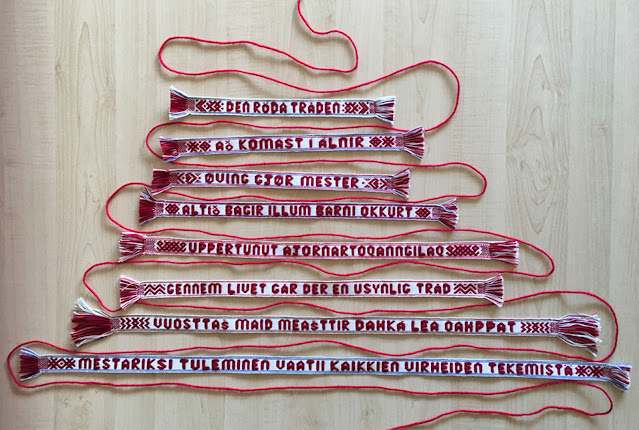I wove items for my display of work at the 5th International Conference on Braiding: Nordic and World Braids and Bands 2022, August 14-19, Svendborg, Denmark.
I enjoy weaving sentences so I have found sayings/proverbs from each of the Nordic countries. I asked a number of people for their suggestions for sayings/proverbs that had some connection to weaving or craft. Each band has a particular motif. Each saying has a border of the colours of the flag for that country.
For Sweden I chose the lovely Leksand pattern which looks like two fish.
The Sámi pattern is found in many areas but I saw it first on a long band in the Cambridge Museum of Archaeology and Anthropology. They have a fascinating collection of Sámi artefacts and plenty of bands on display.
From Norway I chose this pattern with a heart. Norway and Sweden have many variations of heart patterns.
From Denmark I found this wavy pattern which evokes water.
From Iceland I found this motif which originally came from a complex band I saw in a small museum in the north of the country.
Of course, all these six patterns are shared in many countries. The geometrical nature of weaving means that there is a set of patterns which are ideal for weaving on patterned bands. Some cultures favour some types of motifs over others. It has been great fun looking at photographs that I have taken around the region. There are strong connections amongst all the countries which I hope will be reflected in in final piece.
Here are the first four motifs.
The final motifs are for Greenland and the Faroe islands.
Here is the graph for the woven band.
Greenland was settled by Norwegian and Icelandic explorers during the 10th century CE. There were two Viking settlements on the island. One imaginative story about the Viking voyage from Greenland to the New World was written by Nevil Shute in 1940: The Old Captivity. He is an excellent storyteller but this book is unlike his previous stories as it deals with a mystical dream experience of a young pilot whilst recovering from an illness in Greenland. It is a haunting tale. I was reminded of it whilst I was weaving and I have started to reread the book after many years.
I thought about what motif would be suitable for the beginning and end of the band. When analysing motifs, I found that I would give some of them names. When weaving, this naming is useful as it places the design in my mind and fingers. One such design is one I have always called the 'Viking boat.' There are a few coins with Viking boat designs such as this one.
 |
| Viking coin |
Here is the weave chart.
This has been a fascinating project. Here are the sayings:
den röda tråden
gennem livet går der en usynlig tråd.
øving gjør mester
vuosttaš maid meašttir dahká, lea oahppat
að komast í álnir
mestariksi tuleminen vaatii kaikkien virheiden tekemistä
altíð bagir illum barni okkurt
uppertunut ajornartoqanngilag
I am intending to display the bands with a lucetted red cord which joins them together. The red thread is a well used metaphor in Scandinavian countries. It means the heart of the matter or the fundamental issue. It joins friends and communities together and is the link between Nordic countries. The red thread connects us all.
My display of woven sayings.
I will give the translations next month.
Susan J Foulkes August 2022













I am interested in the history of the double-slot heddle. How old is it? Who was the genius that invented it? Was the curved shuttle an independent innovation?
ReplyDeleteI love using mine and like to be able to talk to people about them.
Yes, the double slotted heddle is a wonderful invention. Examples appear in Swedish and Finnish museum dated to the early 19th century. No-one knows who first invented it. The new Sigga heddle was invented recently by a Sami weaving teacher and Stoorstalka in Jokkmokk Sweden. Weavers are still improving their equipment. The curved shuttle is a Sami invention and was originally made from reindeer antler - hence the shape. Again, once you have used it this shape is so comfortable. happy weaving Susan
DeleteThanks for the information. I’ve always called my curved shuttles “reindeer antlers” just because it seemed logical to use that curved shape.
ReplyDelete